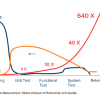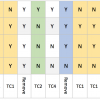 |
When a Number Is Not a Number: Benefits of Random Test Generators We like to hope that we will consider all possible situations when devising our tests, but it’s all too easy to overlook the unusual cases. That’s the benefit of random test generators. We might feel comfortable after testing a few dozen test cases; these tools generate hundreds. With more stuff getting tossed at the wall, there is a greater likelihood that something interesting sticks. |
|
 |
Leveraging Machine Learning to Predict Test Coverage Test coverage is an important metric within test management, and as technology evolves, we‘re able to leverage new trends to predict coverage. Weka, an open source suite of machine learning software, can take your test management beyond spreadsheets to the latest AI technologies, letting you predict your test coverage earlier with greater accuracy. |
|
 |
Top 10 StickyMinds Articles of 2018 With the rise of technology like AI and practices like DevOps, teams everywhere are looking for ways to speed up testing without sacrificing quality. The articles in 2018 reflect that, with the most popular topics being shifting testing left, optimizing tests for continuous integration, and the future of software testing. If you're looking for cutting-edge testing techniques, check out this roundup. |
|
 |
Become a Data Detective Rapid changes in data availability and analysis tools are leading to evolving expectations for the data analyst role. We can do much more than just generate reports; we have the opportunity to not only process data, but convert it into understandable information and use the knowledge revealed by our work to help change happen. |
|
|
|
Responsibly Reporting Performance Test Results: Trends, Noise, and Uncertainty In order for performance test results to have value, you should report them in context. There are two main considerations: How do these compare to previous results? And how can we provide early reports on performance while emphasizing that these are preliminary results that may change significantly as we progress? Here are some ideas for responsible reporting. |
|
 |
7 Simple Tips for Better Performance Engineering Rigorous practices to reinforce performance and resilience, and testing continuously for these aspects, are great ways to catch a problem before it starts. And as with many aspects of testing, the quality of the performance practice is much more important than the quantity of tests being executed. Here are seven simple tips to drive an efficient performance and resilience engineering practice. |
|
 |
5 Key Factors to Achieve Agile Testing in DevOps Part of the path to DevOps requires adoption of agile methodologies. What does it mean for testing when you switch from the traditional waterfall model, with a few long release cycles per year, to the agile model, with changes occurring every two weeks? Here are five key factors to achieve the agile software testing necessary in DevOps. |
|
 |
The Shift-Left Approach to Software Testing The earlier you find out about problems in your code, the less impact they have and the less it costs to remediate them. Therefore, it's helpful to move testing activities earlier in the software development lifecycle—shifting it left in the process timeline. This article explores the shift-left methodology and how you can approach shifting left in your organization. |
|
 |
Mob Programming for Low-Code and No-Code Development In low-code and no-code development, as the names suggest, developers do less actual coding—they create applications through GUIs and configuration instead of traditional programming. But mob programming is still a useful practice, because the entire team can clarify requirements, discuss development and test strategies, and implement the best ideas. Everyone gets to learn and contribute. |
|
 |
Using Decision Tables for Clear, Well-Designed Testing Decision tables are used to test the interactions between combinations of conditions. They provide a clear method to verify testing of all pertinent combinations to ensure that all possible conditions, relationships, and constraints are handled by the software under test. If you need to make sure your test cases cover all outcomes in a scenario, read on to learn how to use decision tables. |
Pages
Upcoming Events
| Jun 02 |
AI Con USA Bridging Minds and Machines |
| Sep 22 |
STARWEST Software Testing Conference in Anaheim & Online |
| Oct 13 |
Agile + DevOps USA The Conference for Agile and DevOps Professionals |
Recommended Web Seminars
| May 23 | How Generative AI Boosts Speed and Quality in Software Testing |
| On Demand | Building Confidence in Your Automation |
| On Demand | Leveraging Open Source Tools for DevSecOps |
| On Demand | Five Reasons Why Agile Isn't Working |
| On Demand | Building a Stellar Team |












